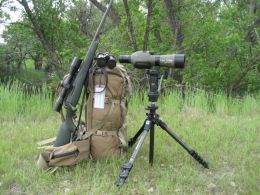How To Choose a Tripod For Your Spotting Scope
- Posted By Jeff Byrnes
- Blog
 Many spotting scopes come bundled with tripods, but my own experience has found that most of these tripods aren’t worth the added weight in the shipping box. It’s always a good idea to purchase a tripod dedicated to your spotting scope, but how do you know what to look for? Here are some tips to help you choose the best tripod for your setup.
Many spotting scopes come bundled with tripods, but my own experience has found that most of these tripods aren’t worth the added weight in the shipping box. It’s always a good idea to purchase a tripod dedicated to your spotting scope, but how do you know what to look for? Here are some tips to help you choose the best tripod for your setup.
Sturdiness and stability are essential
There are a number of choices out there, but the most important things to consider are stability and sturdiness. Especially when you’re dealing with a spotting scope that offers high magnification, having a rugged, stable base to work with allows you the most steady view and the most “bang for your buck.”
You also need to consider the weight of your spotting scope. Bear this in mind: most inexpensive tripods are designed with smaller cameras in mind, not the weight of a spotting scope with an 80mm objective lens or larger. Therefore, the less expensive tripods are usually flimsy, and won’t hold your spotting scope steady.
In the past, we would have recommended a metal tripod, but carbon tripods have advanced in quality so that they offer the same stability and durability, while weighing considerably less and therefore being easier to carry around.
The legs are crucial
Think about the legs on your tripod. Aluminum tripods might be sturdy and cost-effective, but they’re quite a bit heavier. On the other hand, a good carbon fiber tripod cuts the weight while also suppressing vibration, but it maintains the same stability as a less expensive aluminum tripod. In other words, if you want to cut down on the weight of your tripod, be prepared to spend a little more.
Your own height
If you are taller than average, you need a tripod that is taller than average. You should also consider an angled spotting scope, but read our article on choosing between straight and angled spotting scopes to make your final decision on that.
A tall tripod is often recommended, even if you can use a shorter one. The reason for this is that taller tripods often provide better stability and you won’t have to raise the center column as much to match your eye level.
Tripod heads
It’s also a great idea to use a good tripod head, and not necessarily the one that came with your tripod. A pistol grip is often the easiest to use for spotting scopes, because it makes aiming the scope quicker and much more intuitive.
Smooth panning
The most critical element to your tripod head is that it pans smoothly. Make sure whatever you choose has smooth panning and easily manageable vertical adjustments. Without these, you’ll find yourself getting frustrated with your scoping efforts, instead of enjoying yourself.
Final thoughts
You don’t have to spend a lot of time or energy picking out a tripod. The biggest tip I can give you is to make every effort to try before you buy. Failing that, make sure you buy from a retailer with a generous return policy, so you can determine whether or not the tripod truly suits your needs.
What you do need to remember, though, is that you’ve already made a considerable investment in your spotting scope and any other accessories you’re using with it, like your digital camera and camera adapter. Skimping on the tripod will only frustrate you, so budget for a high-quality tripod and don’t settle for the one that comes bundled with your scope.
This post was written by Jeff Byrnes
Hi there! I’m Jeff, an avid outdoorsman and hunter who really likes exploring new technology. I’m especially into hunting optics, which is why I’m writing these reviews! I hope you find my articles helpful in your own shooting and hunting.









Leave a Review